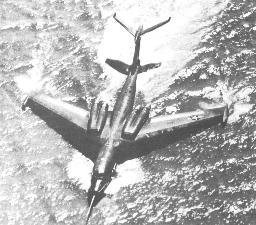
Martin P6M Seamaster
The US Navy questioned for a high performance multi-purpose flying boat in 1952, and
Martin responded with the Model 275. You can see its configuration above, but itīs
interesting that Martin avoided swimmers with the use of tanks on the wingtips and also
the position of the turbojets, which protected them from the spray water.
A crew of five worked in the pressure cockpit.
The first prototype XP6M-1 flew first on 14.07.1955, the second on 18. 05.1956.
Martin got a contract to build six pre-serial planes YP6M-1, and the flight testings resulted
in an order for 24 serial planes P6M-2 SeaMaster with different turbojets.
This contract was cancelled on 21.08.1959 after three completed P6M-2 and the
Navy had to destroy every still existing P6M (As far as I know two of the test planes
were destroyed during test flights in the air, but one had passed Mach 1 and landed safely.)
My comment:
I donīt remember details or my source, thatīs why Iīm presenting the following infos under
the "My comment:" line. In early 1950īs, the USN and USAF wrestled with each other
for the strategic nuclear war (this struggle ended with nuclear ballistic missiles on subs and in silos).
The Air force tried to solve the technical problems of this role with long-range bombers like B-47
and B-52, the Navy with carrier-based bombers (not so successful) and with this flying boat.
Evaluations showed that the P6M was superior to the B-52 in low-level speed and its
independence from big air bases (which were and are very sensitive to first strikes).
But the USAF won this struggle although they had no superior concept or plane for it.
The defeat was bitter. Without any sense (except the sense to kill the evidence for the
lack of superiority of the today legendary B-52) and need came the order to destroy all the
P6M planes. Not one survived for a museum (although it was the last US military flying boat,
the end of an era which started with the Wright Model C before the first world war) and
even the technical drawings were destroyed. It seems as if the USAF really hated this competitor.
The mission profiles of these planes would consist of being refueled by subs or ships during
long-range nuclear strikes, minelaying operations and possibly conventional or nuclear attacks
against land or sea targets.
| Specifications: | |
|---|---|
| Martin P6M SeaMaster heavy U.S. combat flying boat | |
| Dimensions: | |
| Wing span: | 30.48m |
| Length: | 40.84m |
| Height: | 9.45m |
| Weights: | |
| Payload: | 13.608kg |
| Max. Take-Off: | 72,575 kg |
| Performance: | |
| Maximum Speed: | 965km/h and supersonic dives |
| Service Ceiling: | 12.200m |
| Normal Range: | 4.830km without refueling |
| Powerplant: | |
|
four 5.900kg Alllison-J71 turbojets with afterburners (YP6M-1) or four 7.700kg Pratt&Whitney J75-P-2 turbojets (P6M-2) | |
| Armament: | |
|
Six or eight .050 machine guns in the nose and amidships turrets plus 1,814 kg of nukes, bombs or depth charges | |
a link to the "Aviation group"
Thereīs another brilliant htm file about it in the net, Iīll add it as soon as I find it again.
My first source was the book "The Encyclopedia of World Aircraft"
by Orbis Publishing Ltd. and Aerospace Publishing Ltd.